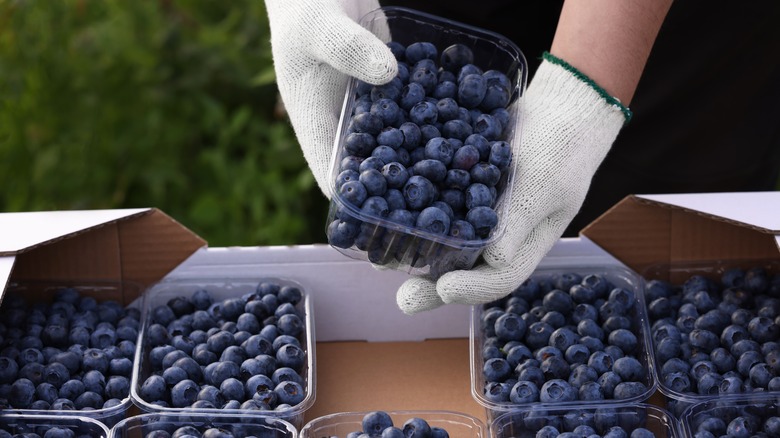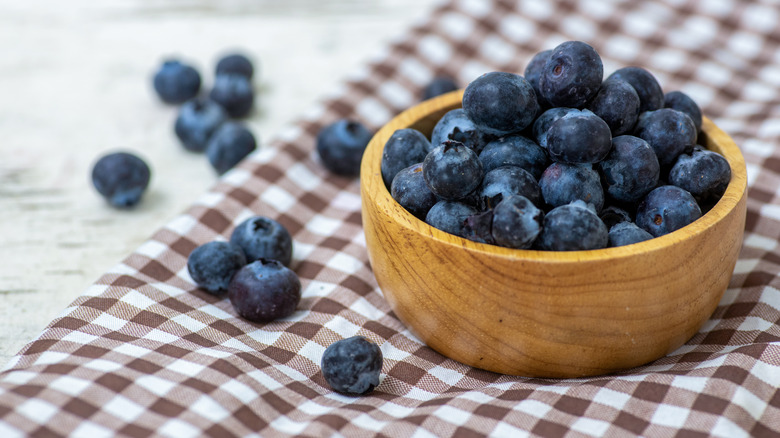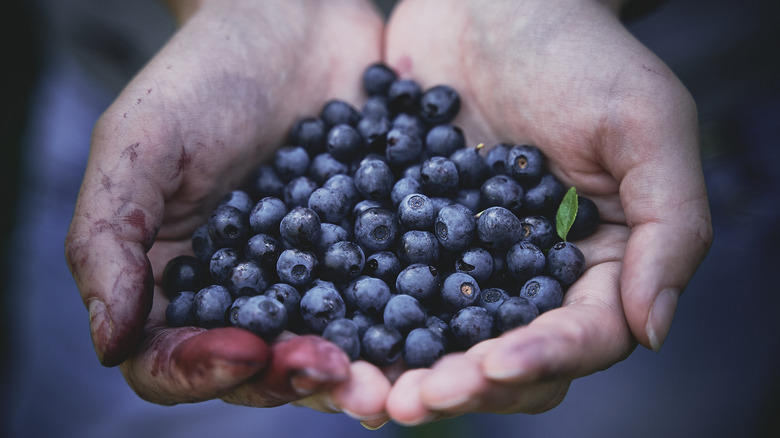Choose The Tastiest Pint Of Blueberries At The Store With A Few Simple Tips
Fresh blueberries add beautiful color and plenty of flavor to so many recipes. They're perfect in sweet treats, such as pancakes or muffins, and they shine in savory dishes, like when they're turned into a compote and served over pork chops. But these tiny fruits don't last long, so when you buy a pack of blueberries at the grocery store, you want to make sure you're getting the most flavorful batch as well as ones that won't go bad within a day of purchase.
There are a number of blueberry varieties you'll find, depending on where you live and the current season. Some are brighter and sweeter than others, but in general, the best blueberries all have a deep blue color — even sometimes resembling purple or black — and few imperfections. When it comes to buying the tastiest ones, you'll want to do a visual check and a smell check, but you should also keep in mind the season and where they were grown.
When buying blueberries, check their color and smell
Blueberries are just that: blue. But depending on the type, there are different shades and variations in their coloring that could throw you off, so know what to look for. For example, bluecrop blueberries are darker than misty blueberries. When buying this fresh produce, rather than focusing too much on the shade of blue, give your attention to the actual shape of the blueberries. Make sure they're plump and full looking — don't go for any that are shriveled. You might also notice a coating on the blueberries that makes them look slightly gray or silver. This is called a bloom, and it's normal.
Fresh, good-quality blueberries don't have much of a smell. If you're willing to take a whiff of each container while shopping, then just make sure you don't notice a heavy sour or off odor that could indicate they are past their prime. You should use your best judgement when it comes to scent.
Do a visual inspection for mold
The downside to selling berries in containers is that they are always piled on top of each other in the carton, which can create excess moisture. If you've ever looked at the underside of a berry container, you might quickly notice that some of the fruit looks wet or even has signs of mold. Make sure to avoid any of these pints.
Do a visual check for any fuzz, which indicates that mold is present. Even if it's only on one blueberry, it can quickly spread to others in the container. If you flip over the blueberries and they look extra mushy underneath, it's also a sign that they're no longer fresh. Pro tip: if you get home and realize there is some mold on the blueberries, don't toss the whole container. Just remove the blueberries that have gone bad (as well as any that were touching them), and then you can eat the remaining fresh ones.
Buy blueberries in season
There is almost no better way to guarantee good-quality blueberries than buying them in-season. Purchasing local blueberries during their prime means little time passes between when the berries are picked and when you add them to your grocery cart. This maximizes their flavor and shelf life, giving you the best berries that last the longest.
If you can't buy local berries in season, take a look at where they're coming from. If they've traveled from another country, it's possible the berries have been coated in chemicals to prevent them from going bad during the lengthy transport. This doesn't necessarily mean they are unsafe to eat, but it might mean they don't taste as juicy and sweet as the fresh kind. During certain times of year, there isn't much you can do about this, but for the best flavor and texture, buy local blueberries from your grocery store whenever you can — they peak in the United States during the summer months and are available from April to September.



